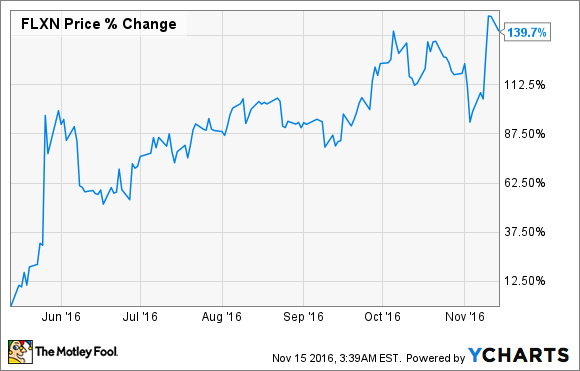
Image source: Pexels.
Investors of Flexion Therapeutics (FLXN) are popping champagne as shares of this tiny biotech have rallied more than 100% over the past six months.
But does Flexion stock still have room to run? With the company on track to file for FDA approval of its lead osteoarthritis injection, Zilretta, by year's end, now might be the perfect opportunity to buy ahead of the news. It's time for a deeper dive into the details.
An overview of Flexion
Flexion Therapeutics is a small-cap specialty pharmaceutical company focused on the development and commercialization of non-opioid pain therapies. Its lead product candidate is Zilretta (also referred to as FX006), an injectable, sustained-release triamcinolone acetonide (TCA) medication for treatment of osteoarthritis (OA) pain in the knee. OA is a type of degenerative arthritis that is caused by the progressive breakdown and eventual loss of cartilage in the joints, characterized by pain, swelling, stiffness, and decreased mobility of the affected joints.
While other TCA therapies already exist and are currently used to treat OA, they are only available as an immediate-release injection (e.g., Kenalog), and the pain-relieving effects wear off after a few weeks at most. Zilretta, on the other hand, is intended to provide at least three months of pain relief for OA patients.
Share-price volatility
In September of last year, Flexion shares took a nosedive after the company announced that Zilretta had failed to meet its primary endpoint of demonstrating superior pain relief relative to placebo at week 12 of therapy in a phase 2b study. So why the recent share-price rebound? Digging into the data makes it clear that Zilretta did demonstrate superior pain relief relative to placebo from weeks one through 11, and even demonstrated significance again at week 13. It therefore appeared that the poor showing at week 12 was only an unfortunate coincidence. This thesis played out when Flexion announced in February of this year positive phase 3 data in OA with the same primary endpoint and a larger sample size. Zilretta also beat out immediate-release TCA on a host of secondary measures, such as joint pain, stiffness, and quality of life. Following this positive phase 3 study, the FDA announced that it would give Zilretta fast-track designation and accept for submission its New Drug Application.
The market opportunity
The osteoarthritis market is quite large, with 25 million to 30 million Americans experiencing some form of OA pain annually. Of these, around 5 million are prescribed injections to the knee in order to provide pain relief for OA symptoms, while other patients are prescribed oral painkillers. The issue with current standards of care for OA pain is that patients have the choice between short-acting injectable therapies and possibly addictive opioid-based oral medications. Zilretta, therefore has the opportunity to combine the benefits of both medications in the form of a long-lasting injectable, non-opioid treatment. According to Flexion management, the global market for this type of OA pain is more than $1.5 billion annually.
Is now the time to buy?
I believe the one-two punch of strong clinical benefit for an underserved market, combined with a large total addressable patient population, makes Flexion an interesting investment opportunity. However, there are still substantial risks involved with this company, as with any pre-commercial biotech investment. With no currently approved drug on the market, Flexion continues to burn through cash as it seeks FDA approval for Zilretta. Additionally, while Zilretta did demonstrate significant clinical benefit for OA pain in phase 3 research, there is no guarantee the FDA will approve Zilretta. Finally, as evidenced by the recently announced secondary offering and resulting price decline of FLXN stock on Tuesday, Flexion will likely have to raise more equity in order to compensate the 60-110 sales representatives necessary to cover the 9,000 orthopedists and rheumatologists responsible for the majority of OA injections. This would, of course, have a dilutive effect to existing shareholders. After a miraculous 100% rally in recent months, I think it's best to sit and wait for a pullback to buy.



